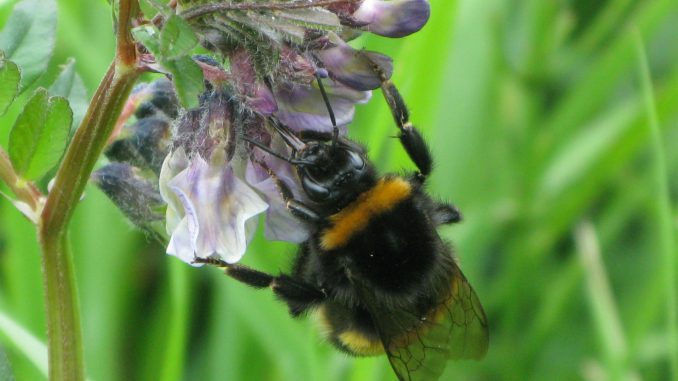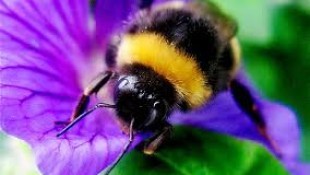
Most people competently underestimate the importance of bees. Yet these busy little creatures are vital to the food chain.
Bee populations across the world are starting to disappear, but why is that and what would happen if they all died?

BYPASS THE CENSORS
Sign up to get unfiltered news delivered straight to your inbox.
You can unsubscribe any time. By subscribing you agree to our Terms of Use
Latest Video
Dissident voice reports: ‘Bees are some of the busiest, most industrious creatures on planet Earth. Basically, they mind their own business whilst performing pollination chores that ultimately provide humankind with every third bite of food. Yes, they’re absolutely critical to the world’s food chain all the way up to your mouth, every third bite.
“Pollen truly is the ‘gold dust of nature’. It is the culmination of the life force of plants,” The Importance of Bees, CC Pollen Co.
But, horror of horrors, bees are dying off like never before. For example, Michigan and Indiana lost 60% of their bee populations this past winter, and it is worse than that; it is a nationwide problem, and even more disquieting, it is a worldwide problem.
Recent scientific research has zeroed-in on the culprits, which are neonicotinoids or “neonics,” which are pesticides manufactured by (readers may have already guessed this) Monsanto and Bayer. However, the two manufacturers claim the pesticides are totally benign. Yes, they honestly say this.
Somebody is wrong.
One answer comes from the Task Force on Systemic Pesticides (“TFSP”). This is the first ever study of all the available science on the issue with scientists contributing from around the world. The four-year study was directed at how and why so many bees, butterflies and other insects, including good ole earthworms, are disappearing so rapidly.
According to Ole Hendrickson, a member of the task force, “Instead of wiping out the top of the food chain, killing hawks and eagles as DDT did, neonics are wiping out the bottom of the food chain.”
In fact, the problem is worse, much worse, more so than even imaginable, because, according to Jean-Marc Bonmatin of the National Centre for Scientific Research (Fr): “Neonics are 5,000 to 10,000 times more toxic than DDT,” Ibid. Five thousand times anything is enormous, hugely overwhelming, and preposterously off the charts.’
What do Bees Pollinate?
You name it, almost every fruit, nut, vegetable, and field crop, and honey fits in the mix.
In short, loss of bees is equivalent to one giant step towards mass starvation.
The Task Force on Systemic Pesticides
According to the Task Force on Systemic Pesticides, Press Release, New Four-Year Scientific Analysis: Systemic Pesticides Pose Global Threat to Biodiversity and Ecosystem Services, June 24, 2014: “Concern about the impact of systemic pesticides on a variety of beneficial species has been growing for the last 20 years, but the science has not been considered conclusive until now.”
Yes, the science is now “conclusive,” and it concludes: “There is clear evidence of harm sufficient to trigger regulatory action.”
Further defining the scope of this worldwide problem, neonics are a nerve poison (Poison? Yes, it’s a nerve poison!) Its effects range from “instant and lethal to chronic.” Purportedly, neonics protect food production, but the evidence is clear that it does the opposite by threatening the very infrastructure, which enables food production. This is equivalent to people taking statins, which, in turn, perversely, elevate cholesterol levels.
Neonics is not a small, isolated market. Neonics have become the pesticide of choice with a worldwide market share of 40%, which begs the question: How can so many farmers be so wrong, using neonics? And, furthermore, is the question as simple as that?
Counterpoint by Bayer
According to Bayer’s web site: “The use of neonicotinoid insecticides in agriculture has been considered by many as having revolutionized the farmer’s ability to control damaging pests in a more environmental-friendly way.”
Fortunately, and smartly, as for Bayer, their internal PR statement says, “ Blah, blah, blah…considered by many….” Namely, considered “by many” is about as ambiguous, incomplete, and uncertain as one can possibly express in words, but it means more than one, and the dictionary says it means, “constituting or forming a large number.” H-m-m, on second thought, that really sounds convincing, but maybe not. Anyway, their referenced study is inconclusive. But, who constitutes “many.”
However, and nevertheless, Bayer substantiates its positive view of neonics via a 15-year study.
Bayer should be somewhat embarrassed, as the study’s conclusion is filled with cautionary statements about more studies required and inconclusiveness, not conclusiveness. And, that is how scientists are supposed to report findings, unless the findings are 100% conclusive. Then, it’s conclusive. So, kudos to Blacquiere, et al on that score; however, and most importantly, the report is remiss of evidence to support Bayer’s self-serving blanket statement that neonics “… control damaging pests in a more environmental-friendly way.”
As such, one can only conclude that, since bees are dropping by the millions, possibly by the billions, originating from some source not part of nature, and since the TFSP study is “conclusive,” conclusively stating that neonics harm, if not kill, bees, then neonics should be banned or heavily regulated, at the least. Of course, banning removes the “at the least” consideration.
A Workable Alternative to Bee Pollination
Similar to bees, people can pollinate plants and trees. This actually, really, truly happened in China, as reported on NPR (National Public Radio) by Robert Krulwich, “How Important Is A Bee?” December 6, 2013.
Here’s the scoop: The bee population disappeared from an apple-growing region of Central China named Maoxian County. Previously, the bees showed up every spring for as long as anybody could remember until one spring in 1997, no bees. Without bees the apple farmers were literally up a creek without a paddle.
Solution: Pollinate the apple trees by hand.
The farmers hired enough workers, using brushes made from chopsticks and chicken feathers, and going from blossom to blossom, replicating the bees, human workers spread the pollen. Remarkably, apple harvests were 30% to 40% greater than with the bees because the horde of human pollinators meticulously pollinated every blossom. Bees, however, are a little sloppy and occasionally miss some blossoms.
Moral of the story: Unemployment may be high in the U.S., but with immigration concerns and border patrols working overtime to eliminate border crossings, where will farmers find the people (many farmers already report shortages of field workers, who are typically migrant workers) willing to do this menial work of pollination and can farmers afford to pay the workers?
The bees do it for free!!!
P.S. One positive, but extremely sad, side benefit to the possibility of an impending loss of all bees, the unemployment rate will drop to zero, but food costs will skyrocket, not a benefit. Otherwise, unless hundreds of thousands maybe even millions, of people go to the fields to pollinate, they’ll be no more fruit, nuts, vegetables, field crops, and honey.
Postscript:
I am attracted to bees because I like honey— it is really delicious. Their product is something we cannot produce, very beautiful, isn’t it? I exploit them too much, I think. Even these insects have certain responsibilities; they work together very nicely. They have no constitution, they have no law, no police, nothing, but they work together effectively. This is because of nature… I think we are behind those small insects.”
— The Dalai Lama



